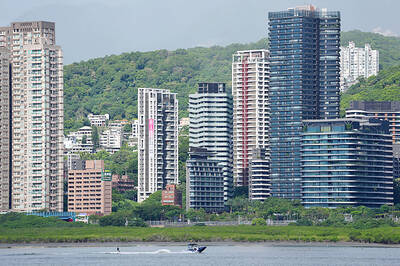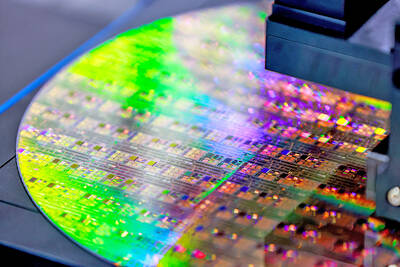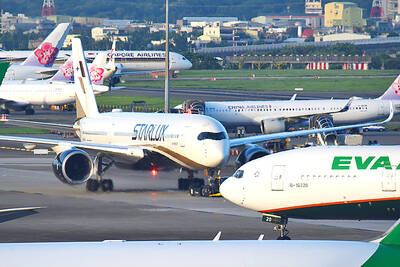The lack of ambitious conclusions on renewable energy at the recent National Conference on Energy can be attributed to the reluctance of Taiwanese officials to learn about renewable energy, the Taipei Times was told by renewable energy campaigners in Germany.
In the last five years, the German Society for Solar Energy (Deutsche Gesellschaft fur Sonnenenergie, DGS), has been contacted by not only Taiwanese government officials but also researchers.
Uwe Hartmann, chief executive officer of the DGS' Berlin Brandenburg section, said on Tuesday that Germany's up-to-date information on renewable energy R&D and strategies for public education have been passed on to Taiwan but nothing has happened.
"There is not enough knowledge in Taiwan about the use of renewable energy," he said.
He has visited Taiwan several times and has helped the Ministry of Education (MOE) design green buildings that use renewable energy and are energy efficient.
However, he said that the influence of such projects was limited. He said the level of solar radiation in southern Taiwan is excellent for solar-energy applications but so far there have been only small-scale solar-thermal energy projects.
"Even in the north, we think there is a potential for using solar energy. But obviously, the Taiwan Power Company [Taipower] has little interest in that," he said.
Hartmann said that delegations from the MOE, the Ministry of Economic Affairs, the Industrial Technology Research Institute and universities have frequently visited Germany to examine renewable-energy projects.
However, he said, the minimal changes in Taiwan's energy policies reflect the reluctance of certain government agencies to admit that renewable energy has advantages.
Hartmann said it had taken Germany more than a decade to reach the stage where planners, non-governmental organizations, architects and decision-makers are well-informed about tie between sustainability and the adoption of renewable energy.
About 10 percent of electricity in Germany now comes from renewable energy. Sixty percent of the markets for Germany's renewable industry are overseas, he said.
Nowadays, governments and society are pushing for more renewable energy in Germany and public education about renewable energy is a priority for not only federal and local governments but also power companies.
For example, a three-year-long Solar Lab exhibition at the Energy Forum in Berlin, which opened last October, is designed to inform people about conserving energy. More than 3,000 people have visited the lab -- sponsored by the Berlin Power company BEWAG -- so far.
"All devices at the lab are designed to help visitors clearly sense abstract energy. Students can tug at a mechanism powered by solar panels. People can observe revolving artistic work connected to solar modules," exhibition organizer Christof Hute said.
Hute calls the lab's design a kind of "solar art performance."
He has also displayed artistic solar devices outdoors at key tourist spots, such as the Brandenburg Gate, in order to reach more people.
In 2003 Berlin generated 10 times more solar current by photovoltaic systems than in 1995. There are also 3,900 solar-thermal energy systems in the city.

Taiwan’s rapidly aging population is fueling a sharp increase in homes occupied solely by elderly people, a trend that is reshaping the nation’s housing market and social fabric, real-estate brokers said yesterday. About 850,000 residences were occupied by elderly people in the first quarter, including 655,000 that housed only one resident, the Ministry of the Interior said. The figures have nearly doubled from a decade earlier, Great Home Realty Co (大家房屋) said, as people aged 65 and older now make up 20.8 percent of the population. “The so-called silver tsunami represents more than just a demographic shift — it could fundamentally redefine the

Businesses across the global semiconductor supply chain are bracing themselves for disruptions from an escalating trade war, after China imposed curbs on rare earth mineral exports and the US responded with additional tariffs and restrictions on software sales to the Asian nation. China’s restrictions, the most targeted move yet to limit supplies of rare earth materials, represent the first major attempt by Beijing to exercise long-arm jurisdiction over foreign companies to target the semiconductor industry, threatening to stall the chips powering the artificial intelligence (AI) boom. They prompted US President Donald Trump on Friday to announce that he would impose an additional

China Airlines Ltd (CAL, 中華航空) said it expects peak season effects in the fourth quarter to continue to boost demand for passenger flights and cargo services, after reporting its second-highest-ever September sales on Monday. The carrier said it posted NT$15.88 billion (US$517 million) in consolidated sales last month, trailing only September last year’s NT$16.01 billion. Last month, CAL generated NT$8.77 billion from its passenger flights and NT$5.37 billion from cargo services, it said. In the first nine months of this year, the carrier posted NT$154.93 billion in cumulative sales, up 2.62 percent from a year earlier, marking the second-highest level for the January-September

Asian e-commerce giant Shein’s (希音) decision to set up shop in a historic Parisian department store has ruffled feathers in the fashion capital. Anger has been boiling since Shein announced last week that it would open its first permanent physical store next month at BHV Marais, an iconic building that has stood across from Paris City Hall since 1856. The move prompted some French brands to announce they would leave BHV Marais, but the department store had already been losing tenants over late payments. Aime cosmetics line cofounder Mathilde Lacombe, whose brand was among those that decided to leave following